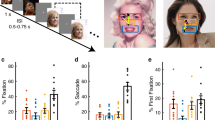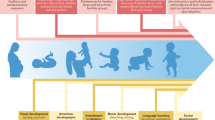Abstract
From what we see to what we hear and from how we feel to what we think, our conscious experiences play an important role in shaping our lives. Because we become aware of only a small subset of our ongoing cognitive and perceptual processes1,2,3,4, explicating the determinants of conscious experiences is a crucial step towards understanding human behaviour. Here we develop a computational data-driven approach for studying the determinants of consciousness and we use it to investigate what is arguably the most important social stimulus: the human face5,6,7. In six experiments with 174 participants, we used this method to uncover a reliable dimension that determines the speed with which different faces reach conscious awareness. This dimension correlates strongly with the perceived power/dominance of a face. We show that the dimension cannot be explained by low-level visual factors and does not describe conscious processing, thereby suggesting that it captures the process of prioritization for consciousness. By visualizing the dimension, we are able to produce a vivid depiction of what unconscious processes prioritize for conscious processing. We propose this method as a means to study the contents and neural correlates of conscious experiences across various domains.
This is a preview of subscription content, access via your institution
Access options
Access Nature and 54 other Nature Portfolio journals
Get Nature+, our best-value online-access subscription
$29.99 / 30 days
cancel any time
Subscribe to this journal
Receive 12 digital issues and online access to articles
$119.00 per year
only $9.92 per issue
Buy this article
- Purchase on Springer Link
- Instant access to full article PDF
Prices may be subject to local taxes which are calculated during checkout




Similar content being viewed by others
Change history
19 January 2018
In the version of this Letter originally published, the image of the face in Fig. 1c was mistakenly visible but should have been blended into the pattern. This has now been corrected.
References
Baars, B. J. In the theatre of consciousness. Global workspace theory, a rigorous scientific theory of consciousness. J. Conscious. Stud. 4, 292–309 (1997).
Erdelyi, M. H. A new look at the new look: perceptual defense and vigilance. Psychol. Rev. 81, 1–25 (1974).
Mack, A. & Rock, I. Inattentional Blindness 33 (MIT Press, Cambridge, MA, 1998).
Simons, D. J. & Rensink, R. A. Change blindness: past, present, and future. Trends Cogn. Sci. 9, 16–20 (2005).
Axelrod, V., Bar, M. & Rees, G. Exploring the unconscious using faces. Trends Cogn. Sci. 19, 35–45 (2015).
Jack, R. E. & Schyns, P. G. Toward a social psychophysics of face communication. Annu. Rev. Psychol. 68, 269–297 (2017).
Oosterhof, N. N. & Todorov, A. The functional basis of face evaluation. Proc. Natl Acad. Sci. USA 105, 11087–11092 (2008).
Most, S. B., Scholl, B. J., Clifford, E. R. & Simons, D. J. What you see is what you set: sustained inattentional blindness and the capture of awareness. Psychol. Rev. 112, 217–242 (2005).
Stoerig, P. & Cowey, A. Blindsight in man and monkey. Brain 120, 535–559 (1997).
Gazzaniga, M. S. Forty-five years of split-brain research and still going strong. Nat. Rev. Neurosci. 6, 653–659 (2005).
Driver, J. & Vuilleumier, P. Perceptual awareness and its loss in unilateral neglect and extinction. Cognition 79, 39–88 (2001).
Tsuchiya, N. & Koch, C. Continuous flash suppression reduces negative afterimages. Nat. Neurosci. 8, 1096–1101 (2005).
Jiang, Y., Costello, P. & He, S. Processing of invisible stimuli: advantage of upright faces and recognizable words in overcoming interocular suppression. Psychol. Sci. 18, 349–355 (2007).
Maurer, D., Grand, R. L. & Mondloch, C. J. The many faces of configural processing. Trends Cogn. Sci. 6, 255–260 (2002).
Haxby, J. V., Hoffman, E. A. & Gobbini, M. I. The distributed human neural system for face perception. Trends Cogn. Sci. 4, 223–233 (2000).
Kanwisher, N., McDermott, J. & Chun, M. M. The fusiform face area: a module in human extrastriate cortex specialized for face perception. J. Neurosci. 17, 4302–4311 (1997).
Freiwald, W. A. & Tsao, D. Y. Functional compartmentalization and viewpoint generalization within the macaque face-processing system. Science 330, 845–851 (2010).
Stein, T., Peelen, M. V. & Sterzer, P. Adults’ awareness of faces follows newborns’ looking preferences. PLoS ONE 6, e29361 (2011).
Zhou, G., Zhang, L., Liu, J., Yang, J. & Qu, Z. Specificity of face processing without awareness. Conscious. Cogn. 19, 408–412 (2010).
Yang, E., Zald, D. H. & Blake, R. Fearful expressions gain preferential access to awareness during continuous flash suppression. Emotion 7, 882–886 (2007).
Chen, Y.-C. & Yeh, S.-L. Look into my eyes and I will see you: unconscious processing of human gaze. Conscious. Cogn. 21, 1703–1710 (2012).
Stein, T., Senju, A., Peelen, M. V. & Sterzer, P. Eye contact facilitates awareness of faces during interocular suppression. Cognition 119, 307–311 (2011).
Gobbini, M. I. et al. Prioritized detection of personally familiar faces. PLoS ONE 8, e66620 (2013).
Stewart, L. H. et al. Unconscious evaluation of faces on social dimensions. J. Exp. Psychol. Gen. 141, 715–727 (2012).
Todorov, A., Dotsch, R., Wigboldus, D. H. J. & Said, C. P. Data-driven methods for modeling social perception. Soc. Pers. Psychol. Compass 5, 775–791 (2011).
Rhodes, G., Jeffery, L., Watson, T. L., Clifford, C. W. G. & Nakayama, K. Fitting the mind to the world: face adaptation and attractiveness after effects. Psychol. Sci. 14, 558–566 (2003).
Dotsch, R., Hassin, R. R. & Todorov, A. Statistical learning shapes face evaluation. Nat. Hum. Behav. 1, 0001 (2016).
Adolphs, R., Nummenmaa, L., Todorov, A. & Haxby, J. V. Data-driven approaches in the investigation of social perception. Phil. Trans. R. Soc. Lond. B 371, 20150367 (2016).
Neri, P., Parker, A. J. & Blakemore, C. Probing the human stereoscopic system with reverse correlation. Nature 401, 695–698 (1999).
Tadin, D., Lappin, J. & Blake, R. Fine temporal properties of center-surround interactions in motion revealed by reverse correlation. J. Neurosci. 26, 2614–2622 (2006).
Gosselin, F. & Schyns, P. G. Superstitious perceptions reveal properties of internal representations. Psychol. Sci. 14, 505–509 (2003).
Shrout, P. E. & Fleiss, J. L. Intraclass correlations: uses in assessing rater reliability. Psychol. Bull. 86, 420–428 (1979).
Stojanoski, B. & Cusack, R. Time to wave good-bye to phase scrambling: creating controlled scrambled images using diffeomorphic transformations. J. Vis. 14, 6 (2014).
Bourdev, L. & Malik, J. Poselets: body part detectors trained using 3D human pose annotations. In 2009 IEEE 12th International Conference on Computer Vision 1365–1372 (IEEE, New York, NY, 2009).
Huth, A. G., de Heer, W. A., Griffiths, T. L., Theunissen, F. E. & Gallant, J. L. Natural speech reveals the semantic maps that tile human cerebral cortex. Nature 532, 453–458 (2016).
Éthier-Majcher, C., Joubert, S. & Gosselin, F. Reverse correlating trustworthy faces in young and older adults. Front. Psychol. 4, 592 (2013).
Jack, R. E., Caldara, R. & Schyns, P. G. Internal representations reveal cultural diversity in expectations of facial expressions of emotion. J. Exp. Psychol. Gen. 141, 19–25 (2012).
Brainard, D. H. The psychophysics toolbox. Spat. Vis. 10, 433–436 (1997).
Sklar, A. Y. et al. Reading and doing arithmetic nonconsciously. Proc. Natl Acad. Sci. USA 109, 19614–19619 (2012).
Acknowledgements
This research was supported by the United States–Israel Binational Science Foundation (grant no. 2013417 to R.R.H. and A.T.). The funders had no role in study design, data collection and analysis, the decision to publish, or preparation of the manuscript.
Author information
Authors and Affiliations
Contributions
Y.A., A.Y.S. R.D. A.T. and R.R.H. developed the main ideas of this research programme. Y.A. and A.Y.S. programmed the experiments. Y.A. ran the experiments and analysed data. R.D. contributed analysis methods and scripts. Y.A. and R.R.H. wrote the manuscript, and R.D., A.Y.S. and T.D. provided extensive feedback on the writing.
Corresponding authors
Ethics declarations
Competing interests
The authors declare no competing financial interests.
Additional information
Publisher’s note: Springer Nature remains neutral with regard to jurisdictional claims in published maps and institutional affiliations.
A correction to this article is available online at https://doi.org/10.1038/s41562-017-0291-2.
Supplementary information
Supplementary Information
Supplementary results, Supplementary methods, Supplementary references, Supplementary Figures 1–2
Video
Supplementary Information
Supplementary Video
Rights and permissions
About this article
Cite this article
Abir, Y., Sklar, A.Y., Dotsch, R. et al. The determinants of consciousness of human faces. Nat Hum Behav 2, 194–199 (2018). https://doi.org/10.1038/s41562-017-0266-3
Received:
Accepted:
Published:
Issue Date:
DOI: https://doi.org/10.1038/s41562-017-0266-3
This article is cited by
-
Dissociating conscious and unconscious influences on visual detection effects
Nature Human Behaviour (2021)
-
Four dimensions characterize attributions from faces using a representative set of English trait words
Nature Communications (2021)
-
Subjectivity and complexity of facial attractiveness
Scientific Reports (2019)
-
Effects of dominance and prestige based social status on competition for attentional resources
Scientific Reports (2019)



